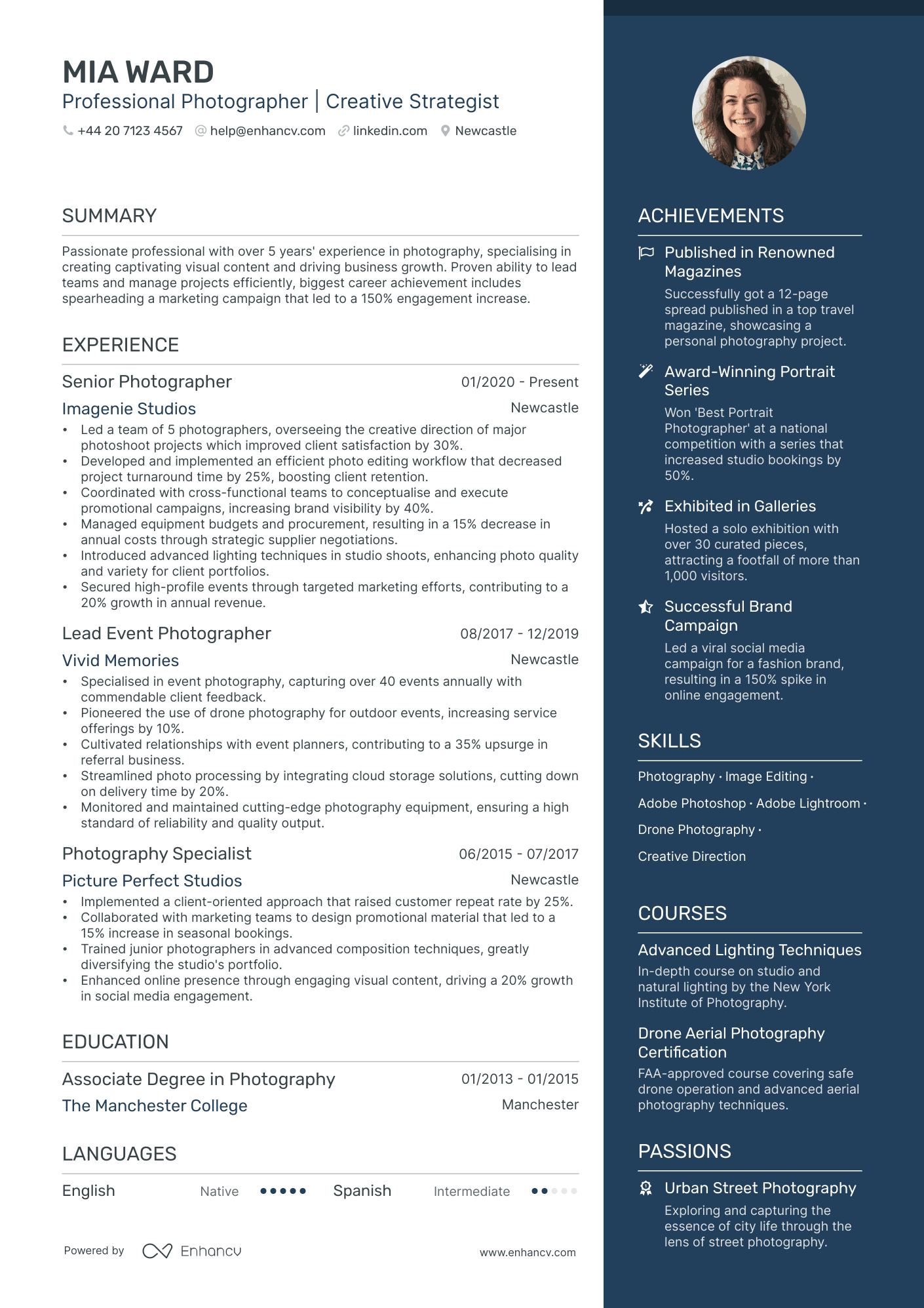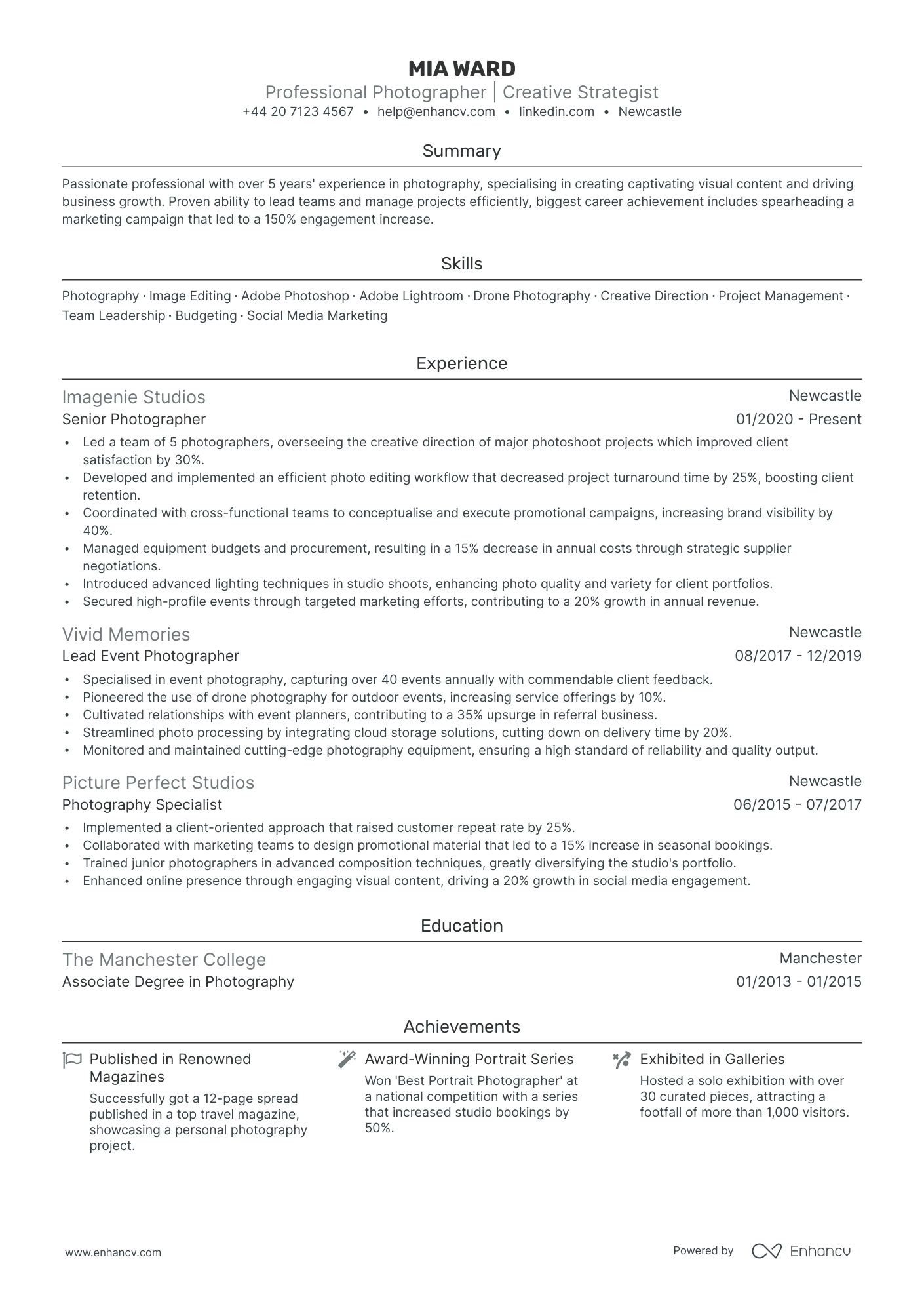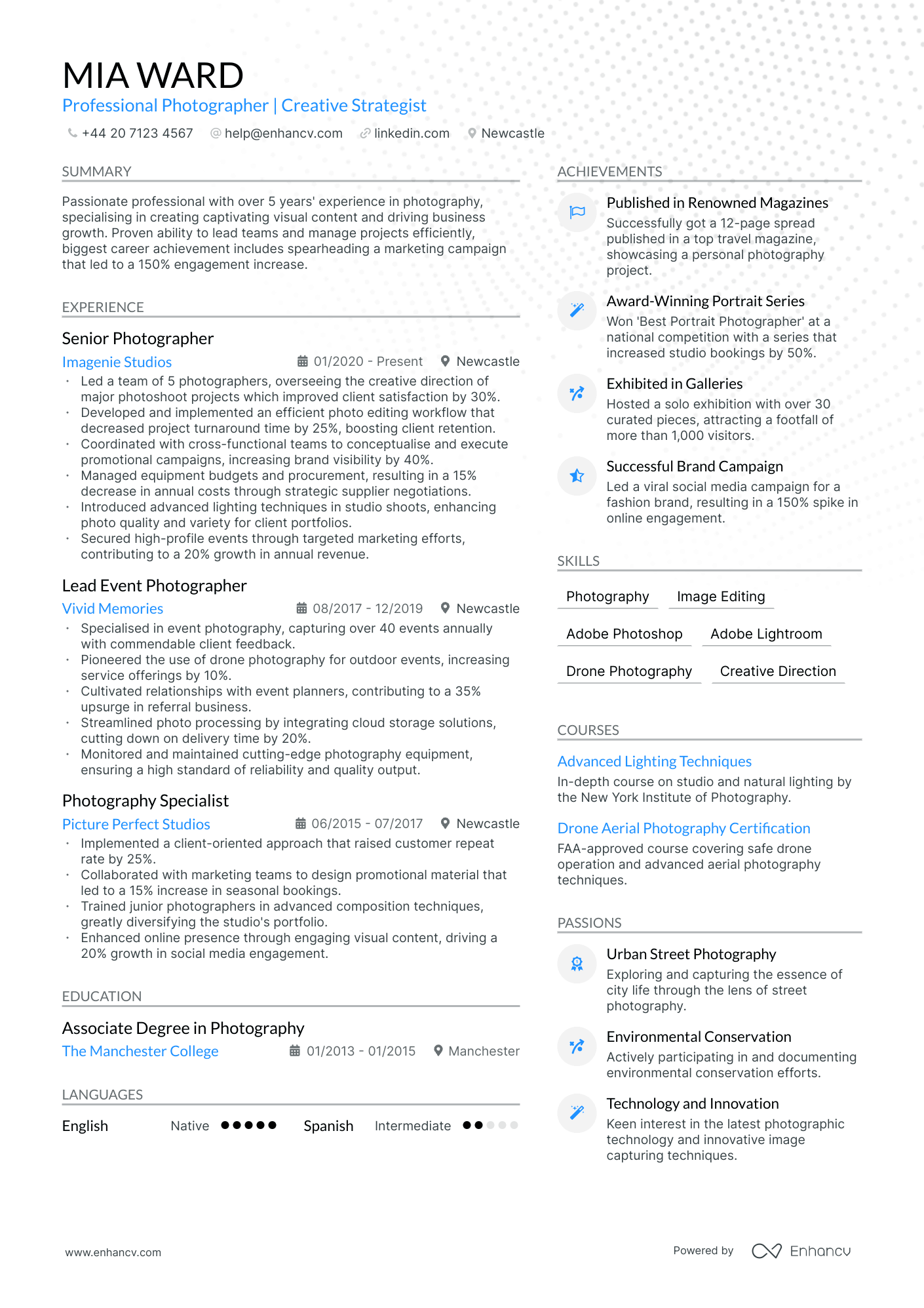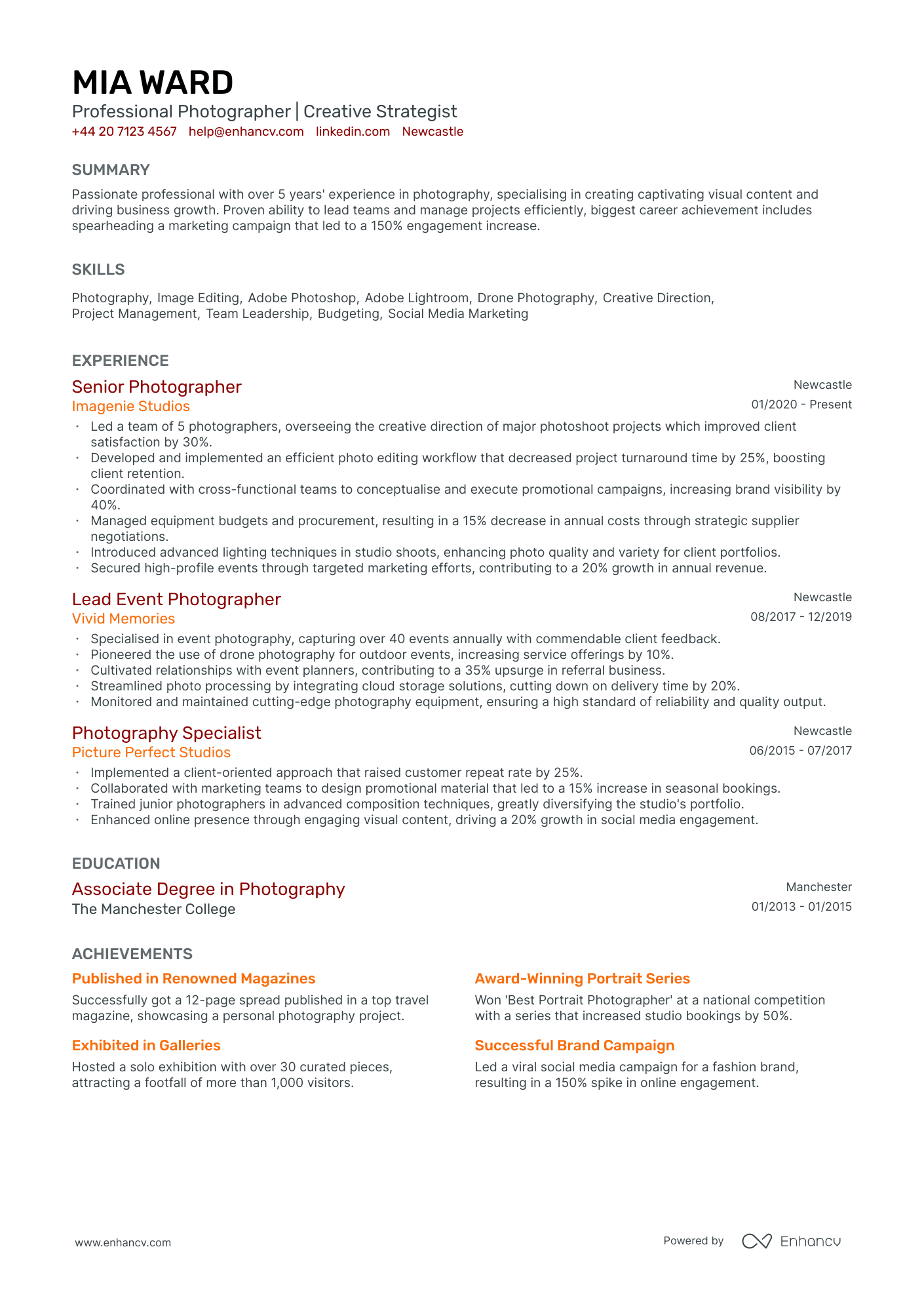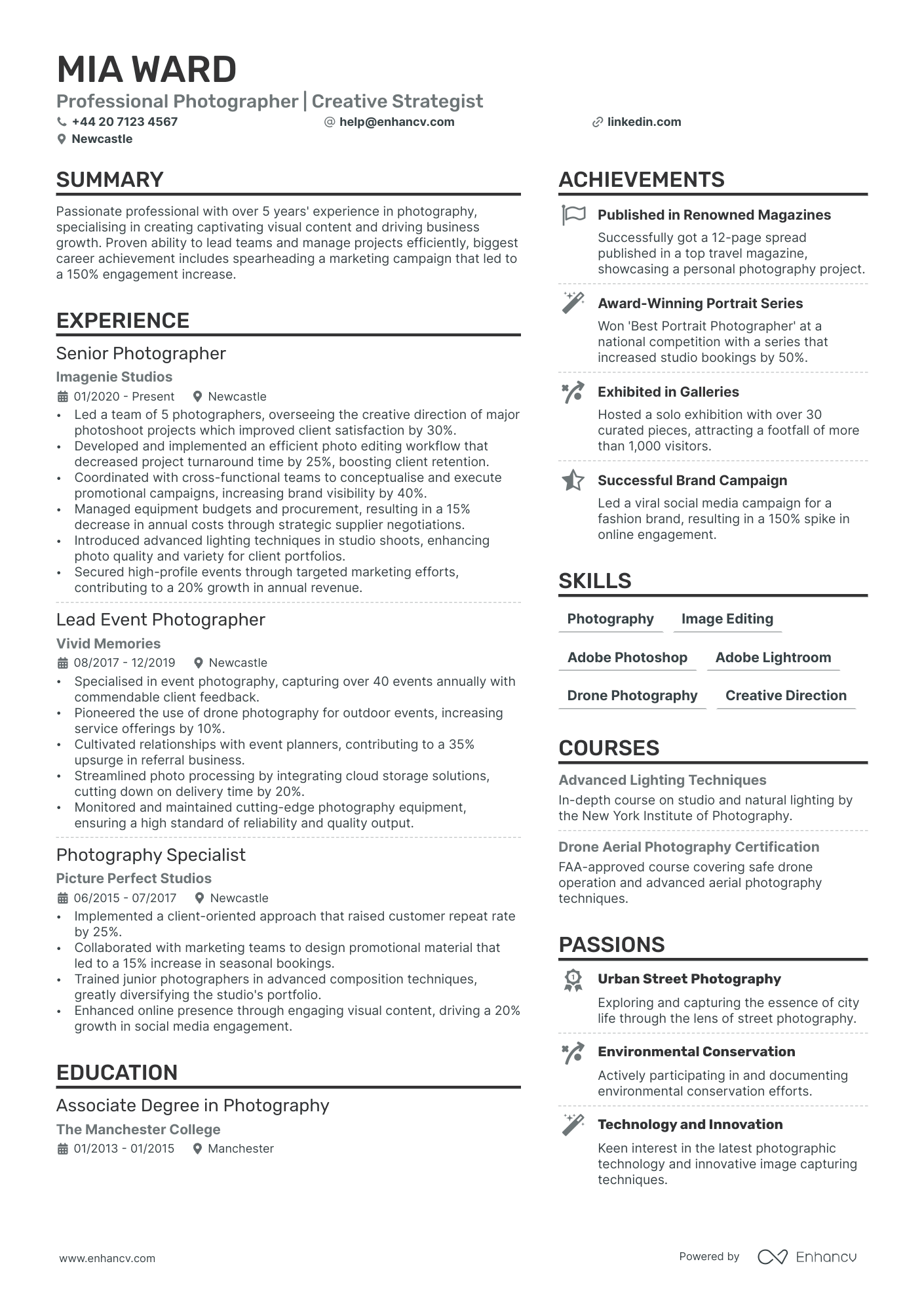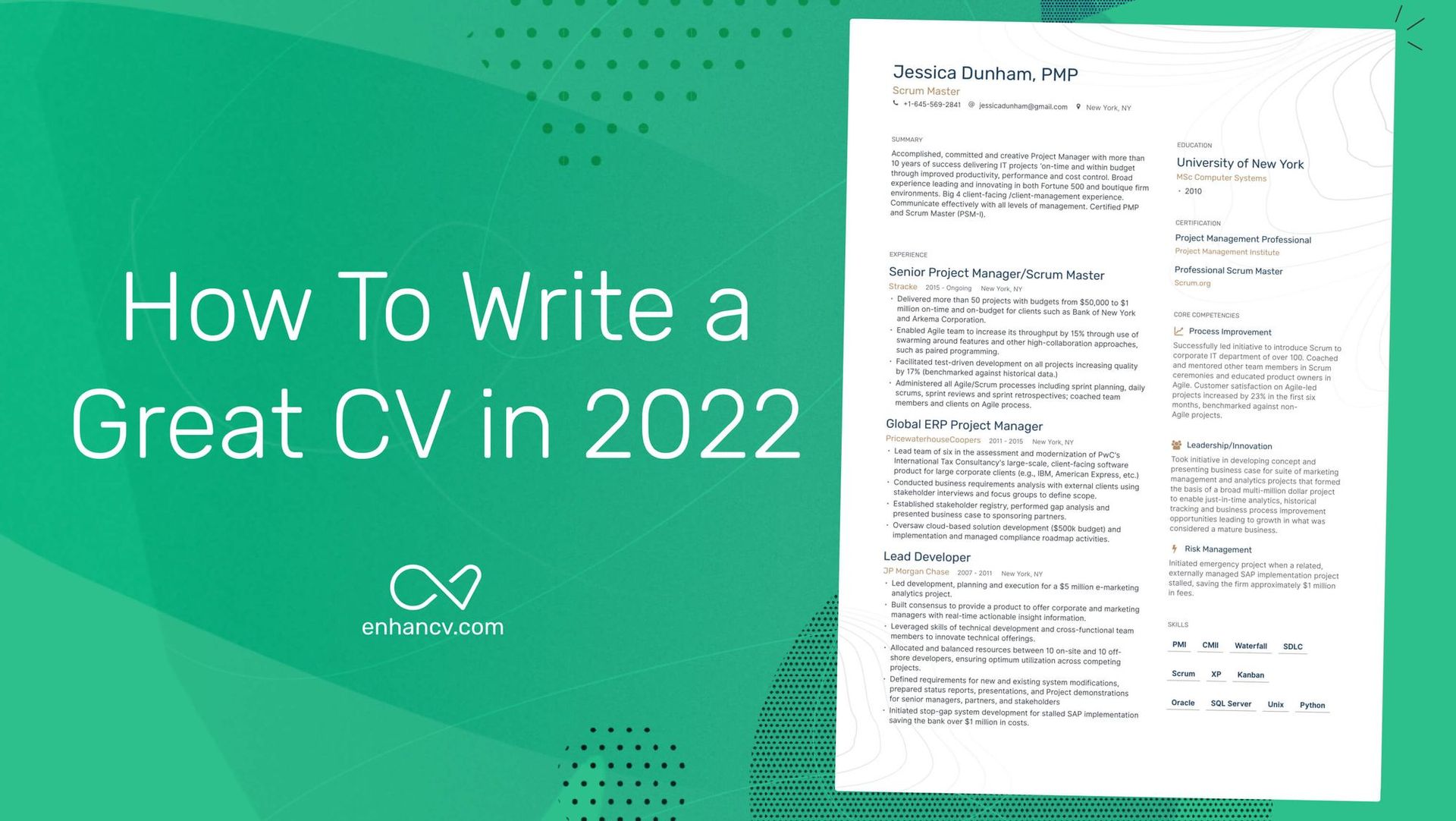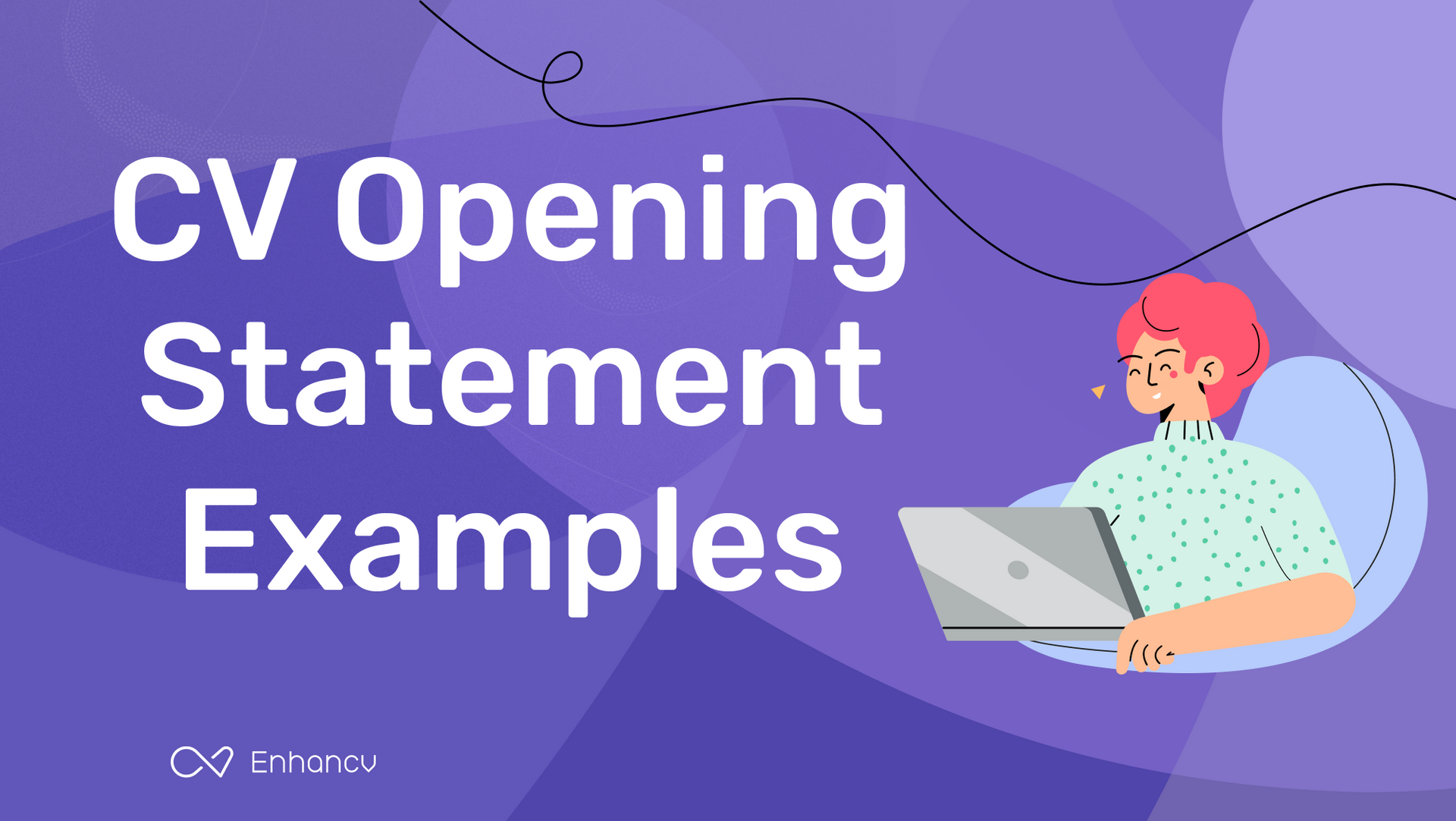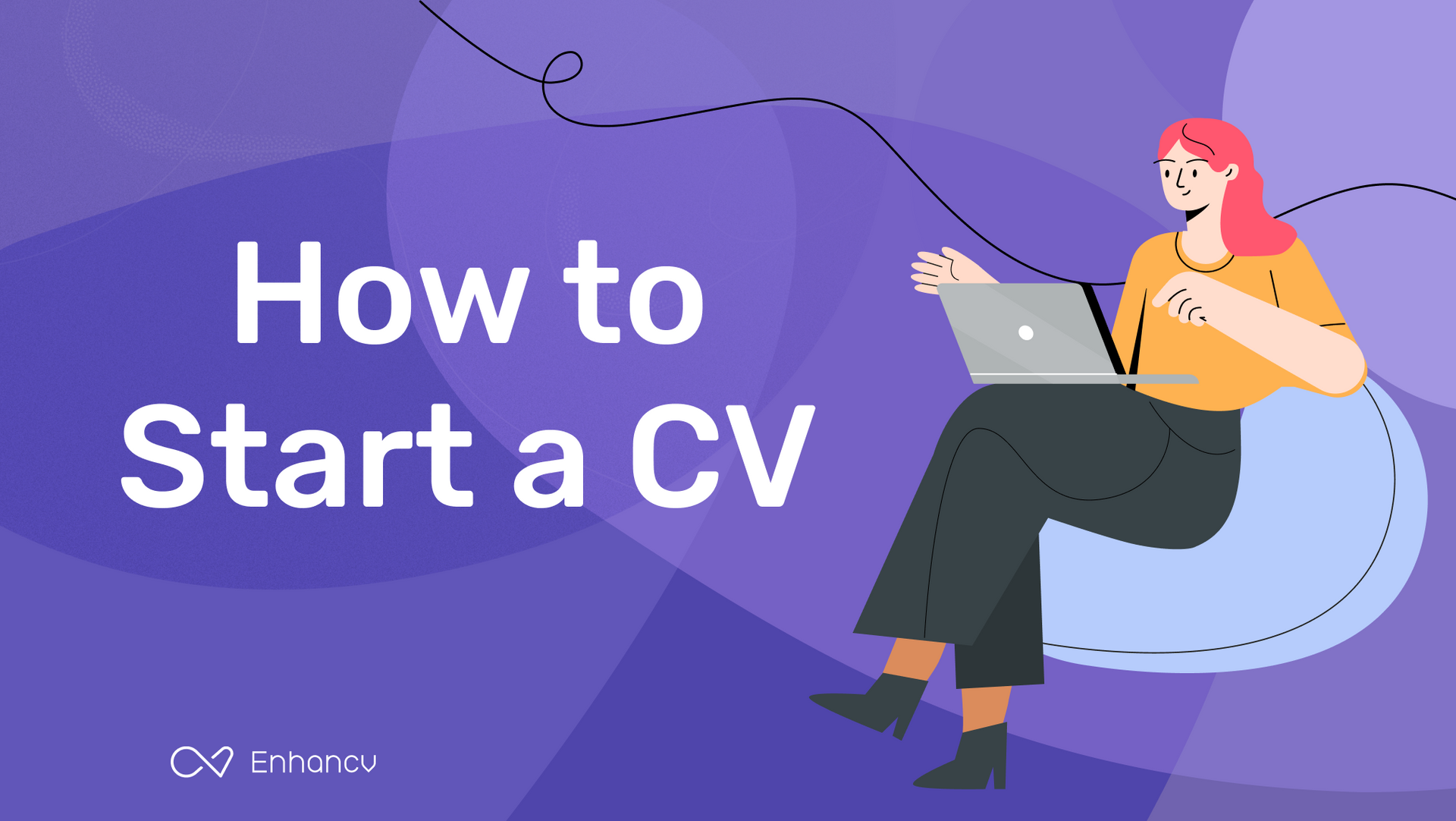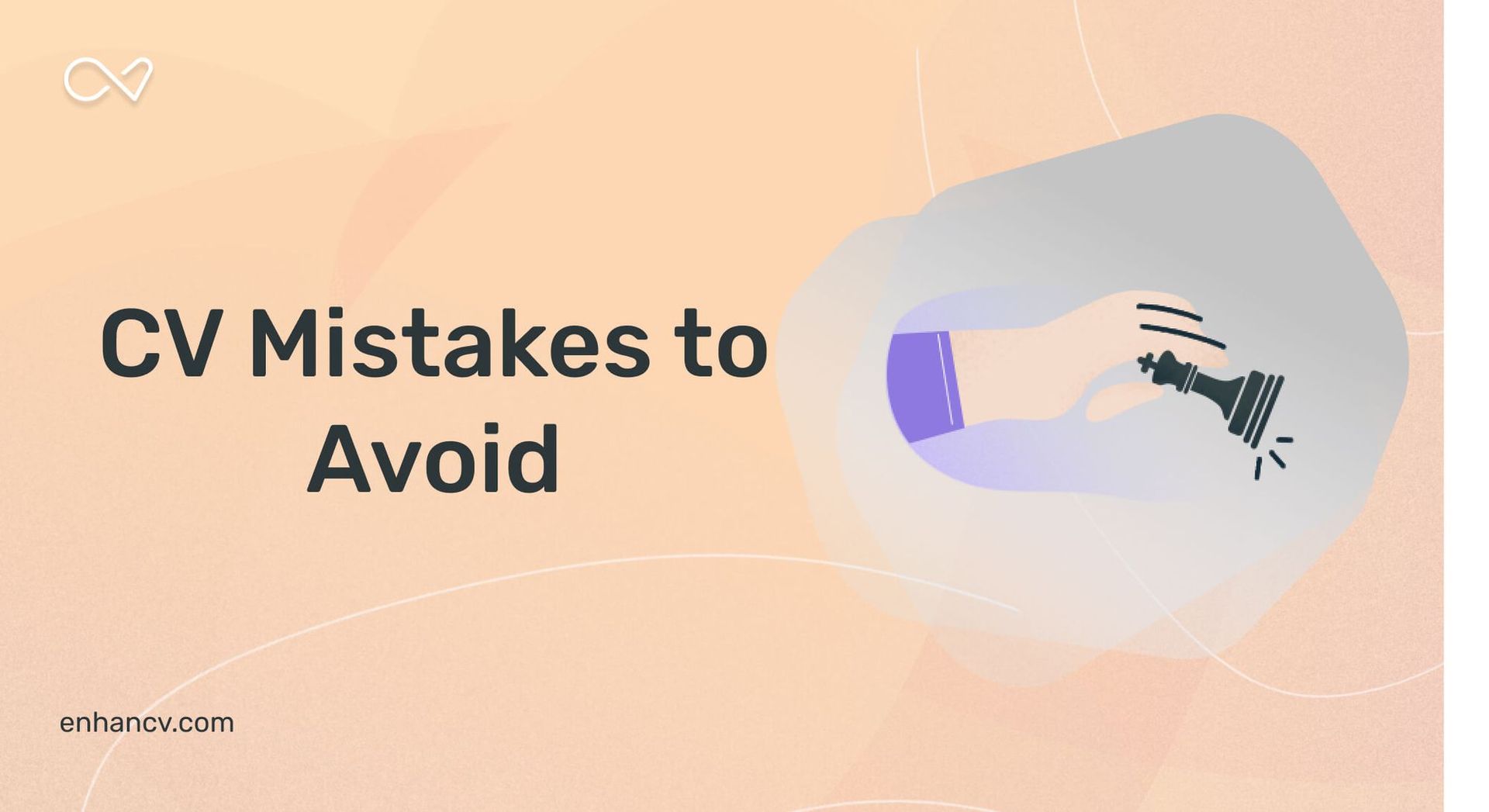Capturing the essence of a fleeting moment remains a persistent CV challenge for any photographer, be it amateur or professional. Our comprehensive guide offers expert tips and techniques to help you seize those transient scenes with precision and flair.
- Create an attention-grabbing header that integrates keywords and includes all vital information;
- Add strong action verbs and skills in your experience section, and get inspired by real-world professionals;
- List your education and relevant certification to fill in the gaps in your career history;
- Integrate both hard and soft skills all through your CV.
Discover more industry-specific guides to help you apply for any role in the links below:
Structuring and formatting your photographer CV for an excellent first impression
The experts' best advice regarding your CV format is to keep it simple and concise. Recruiters assessing your CV are foremost looking out for candidates who match their ideal job profile. Your white space, borders, and margins. You may still be wondering which format you need to export your CV in. We recommend using the PDF one, as, upon being uploaded, it never alters your information or CV design. Before we move on to the actual content of your photographer CV, we'd like to remind you about the Applicant Tracker System (or the ATS). The ATS is a software that is sometimes used to initially assess your profile. Here's what you need to keep in mind about the ATS:- All serif and sans-serif fonts (e.g. Rubik, Volkhov, Exo 2 etc.) are ATS-friendly;
- Many candidates invest in Arial and Times New Roman, so avoid these fonts if you want your application to stand out;
- Both single and double column CVs can be read by the ATS, so it's entirely up to you to select your CV design.
PRO TIP
Incorporate a touch of colour in headers or section breaks, but keep it professional and ensure it doesn’t detract from readability, especially in more conservative industries.
The top sections on a photographer CV
- Professional Summary to encapsulate skills and passion for photography.
- Photography Experience showcasing notable assignments and clients.
- Technical Skills to highlight proficiency in photography software and equipment.
- Portfolio Link to provide instant access to visual work samples.
- Education and Training to show qualifications and photography-specific learning.
What recruiters value on your CV:
- Highlight your visual storytelling skills by including links to your online portfolio or attaching samples of your work that showcase a range of styles and techniques.
- Emphasise your technical expertise with different camera equipment, lighting setups, and editing software, demonstrating your versatility and proficiency in the field.
- Detail any specialisations you have, such as wedding, portrait, or commercial photography, to give potential employers a clear understanding of your niche and expertise.
- Document your experience with project management and collaboration, showing your ability to handle logistics, work with clients, and deliver projects on time and to specification.
- Include testimonials or quotes from previous clients or collaborators to provide credible evidence of your professionalism, reliability, and the quality of your photography.
Recommended reads:
How to present your contact details and job keywords in your photographer CV header
Located at the top of your photographer CV, the header presents recruiters with your key personal information, headline, and professional photo. When creating your CV header, include your:
- Contact details - avoid listing your work email or telephone number and, also, email addresses that sound unprofessional (e.g. koolKittyCat$3@gmail.com is definitely a big no);
- Headline - it should be relevant, concise, and specific to the role you're applying for, integrating keywords and action verbs;
- Photo - instead of including a photograph from your family reunion, select one that shows you in a more professional light. It's also good to note that in some countries (e.g. the UK and US), it's best to avoid photos on your CV as they may serve as bias.
What do other industry professionals include in their CV header? Make sure to check out the next bit of your guide to see real-life examples:
Examples of good CV headlines for photographer:
- Freelance Event Photographer | Expert in Portrait & Lifestyle | Adobe Certified | 5+ Years Experience
- Senior Fashion Photographer | Studio Lighting Guru | Brand Storytelling | BA Hons Photography | 10 Years
- Lead Wedding Photographer | Memorable Story-Capturing | Drone Certified | Editing Wizard | 8 Years Expertise
- Junior Wildlife Photographer | Nature & Conservation Focus | Award-Winning Shots | Extensive Travel Experience | 2 Years
- Headshot Specialist Photographer | Corporate & Performers | Studio Management | Advanced Retouching | 7 Years Professional
- Architectural Photography Director | Urban Design & Interiors | Large-Scale Projects | MA Photography | 12+ Years Excellence
Opting between a photographer CV summary or objective
Within the top one third of your photographer CV, you have the opportunity to briefly summarise your best achievements or present your professional goals and dreams. Those two functions are met by either the CV summary or the objective.
- The summary is three-to-five sentences long and should narrate your best successes, while answering key requirements for the role. Select up to three skills which you can feature in your summary. Always aim to present what the actual outcomes were of using your particular skill set. The summary is an excellent choice for more experienced professionals.
- The objective is more focused on showcasing your unique value as a candidate and defining your dreams and ambitions. Think about highlighting how this current opportunity would answer your career vision. Also, about how you could help your potential employers grow. The objective matches the needs of less experienced candidates, who need to prove their skill set and, in particular, their soft skills.
Still not sure about how to write your CV opening statement? Use some best industry examples as inspiration:
CV summaries for a photographer job:
- With over a decade of capturing vivid imagery, I am an award-winning photographer acclaimed for outstanding portrait and landscape photography. My technical mastery of DSLR and mirrorless systems, paired with my keen ability to encapsulate emotion and tell compelling stories through the lens, culminates in a profound portfolio that has adorned several national publications.
- Accomplished in commercial photography, I possess 8 years of professional experience specialising in product and brand representation. My expertise ranges from studio lighting design to high-speed photography, feeding into my pursuit to create influential visual narratives that have significantly boosted client sales and market presence.
- Transitioning from graphic design, I bring a robust aesthetic sensibility and 5 years of visual communication expertise. My design background aids in developing innovative photographic concepts, and my growing proficiency with Adobe Lightroom and Photoshop ensures high-quality image production suitable for digital and print media.
- As an ex-marketing professional looking to refocus on a passion for photography, my 7-year tenure in advertising has endowed me with a unique perspective for crafting images with mass appeal. My transition is backed by an acute understanding of branding, fresh creative vision, and a recently completed diploma in Professional Photography.
- Seeking to leverage an inherent eye for beauty and compelling composition, my beginner status is offset by a dedicated practice with various camera systems and a portfolio burgeoning with potential. I am eager to refine my skills and contribute fresh, innovative perspectives to the field of professional photography.
- Adept at visual storytelling and hungry to expand my technical repertoire, I aim to establish myself within the world of photography. Through dedicated mentorship and innovative project involvement, I hope to develop a distinct photographic style that resonates with audiences and exemplifies the essence of contemporary visual arts.
The best formula for your photographer CV experience section
The CV experience section is the space where many candidates go wrong by merely listing their work history and duties. Don't do that. Instead, use the job description to better understand what matters most for the role and integrate these keywords across your CV. Thus, you should focus on:
- showcasing your accomplishments to hint that you're results-oriented;
- highlighting your skill set by integrating job keywords, technologies, and transferrable skills in your experience bullets;
- listing your roles in reverse chronological order, starting with the latest and most senior, to hint at how you have grown your career;
- featuring metrics, in the form of percentage, numbers, etc. to make your success more tangible.
When writing each experience bullet, start with a strong, actionable verb, then follow it up with a skill, accomplishment, or metric. Use these professional examples to perfect your CV experience section:
Best practices for your CV's work experience section
- Delivered high-quality wedding photographs for over 100 couples, creating memories with a blend of traditional and candid shots, ensuring client satisfaction and repeat business.
- Expertly managed photo shoots from planning to execution for fashion editorials, collaborating with stylists and makeup artists to produce visually striking images that increased magazine sales.
- Consistently met tight deadlines for a major news outlet as a freelance photojournalist, capturing compelling images that told stories and enhanced articles.
- Specialised in portrait photography, providing guidance on poses and expressions to clients to create engaging and flattering images for portfolios and personal use.
- Pioneered a travel photography blog, attracting 20,000 monthly visitors with stunning visuals and location insights, while partnering with tourism boards for sponsored content.
- Integrated advanced editing techniques using Adobe Photoshop and Lightroom to enhance final photo sets, delivering superior image quality and creative effects.
- Successfully scheduled and conducted over 300 real estate photography sessions, resulting in improved property listings and a 30% faster sale rate for client properties.
- Developed and taught photography workshops for beginner and intermediate levels, focusing on technical skills, creative composition, and post-processing, with excellent participant feedback.
- Implemented a digital asset management system for efficient storage, categorization, and retrieval of over 15,000 images, significantly reducing search time and improving workflow efficiency.
- Developed and executed a comprehensive wedding photography strategy for over 35 weddings, enhancing brand reputation and customer satisfaction.
- Managed editing and retouching for event photos, delivering on average 150+ photos per event within strict deadlines, ensuring timely delivery to clients.
- Implemented an innovative social media campaign for sharing highlight reels, which increased client referrals by 20% within the first year.
- Led a team of 5 photographers in a fast-paced news environment, securing up to 30 photo credits in top-tier publications per month.
- Pioneered a digital archiving system that streamlined the retrieval process, cutting down search times by 50% for historical imagery.
- Cultivated relationships with local authorities and event organisers to gain exclusive access to high-profile events and news scenes.
- Orchestrated large-scale fashion shoots, managing budgets up to £20,000, which directly contributed to a 15% increase in magazine sales.
- Curated a network of fashion designers and models, ensuring high-quality resources were available for seasonal shoots.
- Utilized advanced lighting techniques to create distinctive looks that became part of the magazine’s signature style.
- Captured over 300 property images for real estate listings, which aided in a 20% quicker sale rate compared to non-professionally photographed listings.
- Provided virtual tour photography, significantly elevating the online presence and engagement of listed properties by 40%.
- Initiated a proactive client onboarding process, which improved client preparation and efficiency during the photoshoots.
- Successfully documented over 150 corporate events and conferences, delivering professionally edited images for marketing and PR use.
- Built and maintained robust relationships with corporate clients by consistently meeting high standards of professionalism and quality.
- Created customised branding photography packages that led to an increase in return business by 25% over a two-year period.
- Collaborated with local tourism boards to capture the essence of various destinations, resulting in a 30% increase in brochure and online engagement.
- Managed aerial drone photography projects that showcased landscapes from unique perspectives, earning a feature in National Geographic.
- Conducted photography workshops for travel enthusiasts, further establishing the company’s commitment to the photography community.
- Directed artistic newborn and family photo sessions for over 400 clients, creating memorable portfolios that received overwhelmingly positive feedback.
- Enhanced the studio’s workflow efficiency through the introduction of cutting-edge photo editing software and training sessions for fellow photographers.
- Developed a referral program that increased new customer engagement by 35%, significantly boosting the studio's growth and market presence.
- Spearheaded advertising campaigns by producing striking product imagery, generating a marked improvement in online ad click-through rates by 22%.
- Cultivated a partnership with a local ad agency to deliver consistent, high-quality content for diverse clientele across sectors.
- Introduced a monthly analytics review to better understand image performance, allowing for strategic adjustments that drove a 12% increase in client satisfaction.
What to add in your photographer CV experience section with no professional experience
If you don't have the standard nine-to-five professional experience, yet are still keen on applying for the job, here's what you can do:
- List any internships, part-time roles, volunteer experience, or basically any work you've done that meets the job requirements and is in the same industry;
- Showcase any project you've done in your free time (even if you completed them with family and friends) that will hint at your experience and skill set;
- Replace the standard, CV experience section with a strengths or achievements one. This will help you spotlight your transferrable skills that apply to the role.
Recommended reads:
PRO TIP
Include examples of how you adapted to new tools, environments, or work cultures, showing your flexibility.
Hard skills and soft skills to showcase your unique skill set on your photographer CV
Did you know that your CV will mostly likely be assessed by recruiters based on skill alignment? And that means that the way you feature your key skills across different CV sections will play a crucial role in landing you that first interview. We recommend you add your:
- technical capabilities or hard skills in your CV experience, certificates, projects, etc. Use your past accomplishments to prove your technical capabilities. List up to a dozen different software or hardware in your dedicated skills section to match the job keywords;
- personal and communication skills or soft skills in your CV strengths, achievements, summary/ objective, etc. Soft skills are a bit more difficult to prove. How do you define your aptitude in active listening? So, instead of just listing the skill name, include a tangible metric to show your success.
On a final note, when you're in a hurry to create your profile, you may misspell a particular technology or soft skill. That's why we suggest you copy and paste the particular skill name (or keyword), directly from the job advert. This would also help you to pass any initial Applicant Tracker System (ATS) tests.
Top skills for your photographer CV:
Digital Photography
Photo Editing
Adobe Photoshop
Lightroom
Studio Lighting
Colour Correction
Portrait Photography
Event Photography
Product Photography
Camera Operation
Creative Vision
Attention to Detail
Patience
Flexibility
Effective Communication
Time Management
Client Relations
Problem Solving
Collaboration
Passion for Art
PRO TIP
Focus on describing skills in the context of the outcomes they’ve helped you achieve, linking them directly to tangible results or successes in your career.
Listing your university education and certificates on your photographer CV
The best proof of your technical capabilities would be your education and certifications sections. Your education should list all of your relevant university degrees, followed up by their start and completion dates. Make sure to also include the name of the university/-ies you graduated from. If you happen to have less professional experience (or you deem it would be impressive and relevant to your application), spotlight in the education section:
- that you were awarded a "First" degree;
- industry-specific coursework and projects;
- extracurricular clubs, societies, and activities.
When selecting your certificates, first ask yourself how applicable they'd be to the role. Ater your initial assessment, write the certificate and institution name. Don't miss out on including the completion date. In the below panel, we've curated relevant examples of industry-leading certificates.
PRO TIP
Order your skills based on the relevance to the role you're applying for, ensuring the most pertinent skills catch the employer's attention first.
Recommended reads:
Key takeaways
Here are five things you need to remember about writing your photographer CV for success:
- Sort your experience based on the reverse chronological order, starting with your most recent career items, to showcase how you've grown your career;
- Include within your CV header your relevant contact details, a headline that could spotlight your unique value, and a photo - if you're applying for roles outside the UK or US;
- Decide to use the CV summary, if you happen to have more professional experience, and an objective, if you want to showcase your career goals;
- Within the experience section, write your bullets using action verbs, skills, and success, instead of just merely listing your on-the-job responsibilities;
- Prove your technical skills, using your education and certificates, and your soft skills, with your achievements and strengths sections.
